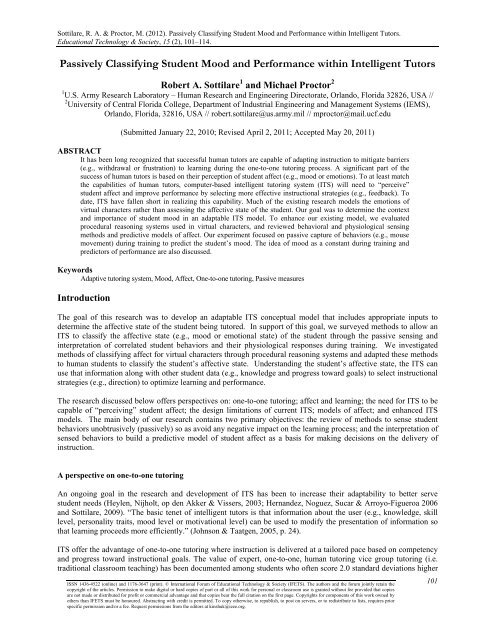April 2012 Volume 15 Number 2 - Educational Technology & Society
April 2012 Volume 15 Number 2 - Educational Technology & Society
April 2012 Volume 15 Number 2 - Educational Technology & Society
Create successful ePaper yourself
Turn your PDF publications into a flip-book with our unique Google optimized e-Paper software.
Sottilare, R. A. & Proctor, M. (<strong>2012</strong>). Passively Classifying Student Mood and Performance within Intelligent Tutors.<br />
<strong>Educational</strong> <strong>Technology</strong> & <strong>Society</strong>, <strong>15</strong> (2), 101–114.<br />
Passively Classifying Student Mood and Performance within Intelligent Tutors<br />
Robert A. Sottilare 1 and Michael Proctor 2<br />
1 U.S. Army Research Laboratory – Human Research and Engineering Directorate, Orlando, Florida 32826, USA //<br />
2 University of Central Florida College, Department of Industrial Engineering and Management Systems (IEMS),<br />
Orlando, Florida, 32816, USA // robert.sottilare@us.army.mil // mproctor@mail.ucf.edu<br />
(Submitted January 22, 2010; Revised <strong>April</strong> 2, 2011; Accepted May 20, 2011)<br />
ABSTRACT<br />
It has been long recognized that successful human tutors are capable of adapting instruction to mitigate barriers<br />
(e.g., withdrawal or frustration) to learning during the one-to-one tutoring process. A significant part of the<br />
success of human tutors is based on their perception of student affect (e.g., mood or emotions). To at least match<br />
the capabilities of human tutors, computer-based intelligent tutoring system (ITS) will need to “perceive”<br />
student affect and improve performance by selecting more effective instructional strategies (e.g., feedback). To<br />
date, ITS have fallen short in realizing this capability. Much of the existing research models the emotions of<br />
virtual characters rather than assessing the affective state of the student. Our goal was to determine the context<br />
and importance of student mood in an adaptable ITS model. To enhance our existing model, we evaluated<br />
procedural reasoning systems used in virtual characters, and reviewed behavioral and physiological sensing<br />
methods and predictive models of affect. Our experiment focused on passive capture of behaviors (e.g., mouse<br />
movement) during training to predict the student’s mood. The idea of mood as a constant during training and<br />
predictors of performance are also discussed.<br />
Keywords<br />
Adaptive tutoring system, Mood, Affect, One-to-one tutoring, Passive measures<br />
Introduction<br />
The goal of this research was to develop an adaptable ITS conceptual model that includes appropriate inputs to<br />
determine the affective state of the student being tutored. In support of this goal, we surveyed methods to allow an<br />
ITS to classify the affective state (e.g., mood or emotional state) of the student through the passive sensing and<br />
interpretation of correlated student behaviors and their physiological responses during training. We investigated<br />
methods of classifying affect for virtual characters through procedural reasoning systems and adapted these methods<br />
to human students to classify the student’s affective state. Understanding the student’s affective state, the ITS can<br />
use that information along with other student data (e.g., knowledge and progress toward goals) to select instructional<br />
strategies (e.g., direction) to optimize learning and performance.<br />
The research discussed below offers perspectives on: one-to-one tutoring; affect and learning; the need for ITS to be<br />
capable of “perceiving” student affect; the design limitations of current ITS; models of affect; and enhanced ITS<br />
models. The main body of our research contains two primary objectives: the review of methods to sense student<br />
behaviors unobtrusively (passively) so as avoid any negative impact on the learning process; and the interpretation of<br />
sensed behaviors to build a predictive model of student affect as a basis for making decisions on the delivery of<br />
instruction.<br />
A perspective on one-to-one tutoring<br />
An ongoing goal in the research and development of ITS has been to increase their adaptability to better serve<br />
student needs (Heylen, Nijholt, op den Akker & Vissers, 2003; Hernandez, Noguez, Sucar & Arroyo-Figueroa 2006<br />
and Sottilare, 2009). “The basic tenet of intelligent tutors is that information about the user (e.g., knowledge, skill<br />
level, personality traits, mood level or motivational level) can be used to modify the presentation of information so<br />
that learning proceeds more efficiently.” (Johnson & Taatgen, 2005, p. 24).<br />
ITS offer the advantage of one-to-one tutoring where instruction is delivered at a tailored pace based on competency<br />
and progress toward instructional goals. The value of expert, one-to-one, human tutoring vice group tutoring (i.e.<br />
traditional classroom teaching) has been documented among students who often score 2.0 standard deviations higher<br />
ISSN 1436-4522 (online) and 1176-3647 (print). © International Forum of <strong>Educational</strong> <strong>Technology</strong> & <strong>Society</strong> (IFETS). The authors and the forum jointly retain the<br />
copyright of the articles. Permission to make digital or hard copies of part or all of this work for personal or classroom use is granted without fee provided that copies<br />
are not made or distributed for profit or commercial advantage and that copies bear the full citation on the first page. Copyrights for components of this work owned by<br />
others than IFETS must be honoured. Abstracting with credit is permitted. To copy otherwise, to republish, to post on servers, or to redistribute to lists, requires prior<br />
specific permission and/or a fee. Request permissions from the editors at kinshuk@ieee.org.<br />
101

















